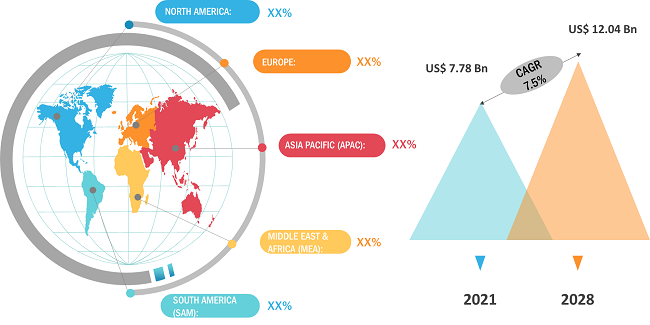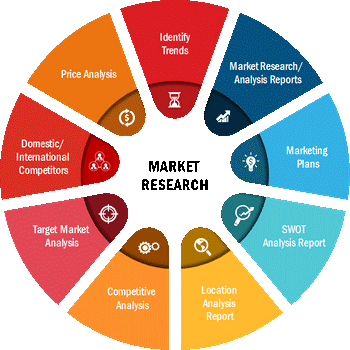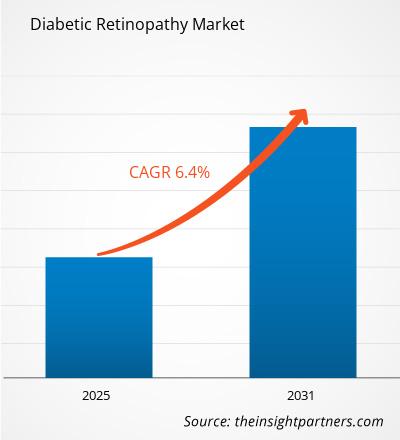Il mercato della retinopatia diabetica è si prevede che crescerà da 7,78 miliardi di dollari nel 2021 a 12,04 miliardi di dollari entro il 2031; si prevede che crescerà a un CAGR del 6,5% dal 2022 al 2031.
Il diabete è una delle malattie non trasmissibili più comunemente diagnosticate. La crescente incidenza del diabete è stata attribuita alla crescita del retinopatia diabetica ; mercato. La retinopatia diabetica è caratterizzata da visione offuscata e cecità poiché elevati livelli di zucchero danneggiano la retina. La retinopatia diabetica è caratterizzata da visione offuscata e cecità poiché un livello elevato di zucchero danneggia la retina. Secondo i dati dei Centri per il controllo e la prevenzione delle malattie (CDC), la retinopatia diabetica colpisce circa un terzo delle persone con diabete di età superiore ai 40 anni e più di 4,2 milioni di pazienti vivono attualmente negli Stati Uniti con retinopatia diabetica. Di conseguenza, i leader di mercato stanno lavorando allo sviluppo di trattamenti innovativi per la retinopatia diabetica e sono allo studio un’ampia gamma di nuovi trattamenti correlati. Ad esempio, nel maggio 2021, Regeneron Pharmaceuticals, Inc. ha ricevuto l'approvazione della FDA per EYLEA® (Aflibercept) Iniezione per il trattamento della retinopatia diabetica.
DINAMICHE DEL MERCATO
La crescita del mercato della retinopatia diabetica è attribuito principalmente alla crescente prevalenza del diabete, all’aumento della popolazione geriatrica e all’aumento dei casi di retinopatia diabetica. Tuttavia, la lenta approvazione dei farmaci e la mancanza di oftalmologi esperti stanno ostacolando la crescita del mercato.
AMBITO DI MERCATO
L'"Analisi del mercato globale della retinopatia diabetica fino al 2031" L’obiettivo del report è fornire una panoramica del mercato della retinopatia diabetica con una segmentazione completa del mercato in base al tipo, al trattamento e al canale di distribuzione. Il rapporto fornisce statistiche chiave di mercato basate sulle prestazioni dei principali attori. Offre inoltre tendenze e opportunità chiave nel mercato.
Approfondimenti strategici
SEGMENTAZIONE DEL MERCATO
Il mercato globale della retinopatia diabetica è segmentato in tipo, trattamento e distribuzione. In base alla tipologia, il mercato è suddiviso in retinopatia diabetica proliferativa e retinopatia diabetica non proliferativa. In base al trattamento, il mercato è segmentato in farmaci anti-VEGF, steroid iniezione, interventi chirurgici laser e vitrectomia. In base al canale di distribuzione, il mercato è segmentato in farmacie al dettaglio, farmacie ospedaliere e altri.
< span style="font-family: verdana, geneva, sans-serif; font-size: 10pt;">
Il mercato globale della retinopatia diabetica è segmentato in cinque regioni principali: Nord America, Europa, Asia Pacifico, Medio Oriente e Asia. Africa e Sud & America Centrale. Il rapporto copre l'analisi e le previsioni di 18 paesi in tutto il mondo insieme alle tendenze e alle opportunità prevalenti in queste regioni.
Il Nord America ha dominato il mercato della retinopatia diabetica con una quota di circa il 38% nel 2021. La crescita del mercato nella regione è principalmente attribuita alla presenza di un'enorme popolazione diabetica insieme alla presenza di importanti attori del mercato come come Abbott Laboratories, Alimera Science, Allergan Plc, Regeneron Pharmaceuticals Inc. e Pfizer. La figura seguente mostra il trend di crescita dei ricavi nel mercato della retinopatia diabetica del Nord America:
 Fonte: analisi dei partner Insight
Fonte: analisi dei partner Insight
Il rapporto analizza i fattori che influenzano, come fattori trainanti, restrizioni, opportunità e le tendenze future, che incidono sul mercato della retinopatia diabetica. Fornisce inoltre un'analisi PEST esaustiva dei fattori che incidono sul mercato della retinopatia diabetica.
IMPATTO DELLA PANDEMIA DA COVID-19
La pandemia COVID-19 ha avuto un impatto negativo sul mercato della retinopatia diabetica. Ciò ha portato a disagi nelle strutture sanitarie, in particolare nelle cliniche oftalmologiche. Le visite ambulatoriali sono state ridotte durante la pandemia, il che ha comportato una diagnosi tardiva di retinopatia diabetica, che alla fine ha comportato una diminuzione della domanda di farmaci per la retinopatia diabetica. Secondo lo studio di Strata Decision Technology, durante la prima ondata di COVID-19 il mercato dell’oftalmologia ha perso l’81% della quota in volume. Inoltre, circa il 30% dei pazienti affetti da retinopatia diabetica ha mancato le visite cliniche durante la pandemia.
Inoltre, la chiusura delle unità produttive, il drastico declino economico, i lockdown nazionali, la chiusura delle strutture logistiche, il ritardo negli studi clinici e la diminuzione delle procedure diagnostiche sono altri fattori principali responsabili del calo della domanda di retinopatia diabetica. Il rinvio delle attività di vendita, la riduzione delle attività di ricerca e sviluppo intraprese dai leader per lanciare prodotti avanzati e le battute d'arresto economiche vissute dai pazienti hanno portato a un drammatico calo della crescita del mercato durante il 2021. Tuttavia, si prevede che il mercato si riprenderà entro la metà del 2022. poiché si osserva la progressione del diabete nei pazienti durante il periodo COVID-19, che alla fine si traduce in un aumento del tasso di incidenza della retinopatia diabetica. Oltre a ciò, la performance positiva dei principali farmaci per la retinopatia diabetica durante i primi trimestri del 2022 indica anche la ripresa del mercato della retinopatia diabetica.
ATTORI DEL MERCATO
Il rapporto copre gli sviluppi chiave nel mercato della retinopatia diabetica. Diverse aziende si stanno concentrando su strategie di crescita organica, come lanci di prodotti, approvazioni di prodotti, brevetti ed eventi. Strategie di crescita inorganica come acquisizioni, partnership e collaborazioni hanno incoraggiato l’espansione del business e della base di clienti degli attori del mercato. Si prevede che gli operatori di mercato che operano nel mercato della retinopatia diabetica sperimenteranno opportunità di crescita redditizie nei prossimi anni con la crescente domanda di farmaci per la retinopatia diabetica.
Il rapporto include anche i profili delle principali aziende del mercato della retinopatia diabetica, insieme alle loro analisi SWOT e strategie di mercato. Si concentra inoltre sui principali attori del settore con informazioni quali profili aziendali, componenti e servizi offerti, informazioni finanziarie negli ultimi tre anni e sviluppi chiave negli ultimi cinque anni. Di seguito è riportato l'elenco di alcune aziende impegnate nel mercato dei farmaci per la retinopatia diabetica:
- Abbott Laboratories
- Alimera Science
- Allergan Plc
- Ampio Pharmaceuticals
- Bayer AG
- F. Hoffmann-LA Roche
- Novartis International AG
- PFIZER
- Regeneron Pharmaceuticals Inc
- Valeant Pharmaceutical
Il team di ricerca e analisi dedicato del partner Insight è composto da professionisti esperti con competenze statistiche avanzate e offre varie opzioni di personalizzazione nello studio esistente.

- Analisi storica (2 anni), anno base, previsione (7 anni) con CAGR
- Analisi PEST e SWOT
- Valore/volume delle dimensioni del mercato - Globale, regionale, nazionale
- Industria e panorama competitivo
- Set di dati Excel



Report Coverage
Revenue forecast, Company Analysis, Industry landscape, Growth factors, and Trends

Segment Covered
This text is related
to segments covered.

Regional Scope
North America, Europe, Asia Pacific, Middle East & Africa, South & Central America

Country Scope
This text is related
to country scope.
Domande frequenti
The diabetic retinopathy market is estimated to grow with a CAGR of 6.4% from 2023 to 2031
The diabetic retinopathy market majorly consists of players such as Abbott Laboratories, Alimera Science, Allergan Plc among others
Asia-Pacific region is likely to witness the fastest growth rate during the forecast period.
The market drivers include the increasing prevalence of diabetes and rising geriatric population, which are driving the diabetic retinopathy market
Personalised medicine is likely to remain the key trend during the forecast period.
North America dominated the diabetic retinopathy market in 2023
Trends and growth analysis reports related to Life Sciences : READ MORE..
The List of Companies
- Abbott Laboratories
- Alimera Science
- Allergan Plc
- Ampio Pharmaceuticals
- Bayer AG
- F. Hoffmann-LA Roche
- Novartis International AG
- PFIZER
- Regeneron Pharmaceuticals Inc
- Valeant Pharmaceutical
The Insight Partners performs research in 4 major stages: Data Collection & Secondary Research, Primary Research, Data Analysis and Data Triangulation & Final Review.
- Data Collection and Secondary Research:
As a market research and consulting firm operating from a decade, we have published and advised several client across the globe. First step for any study will start with an assessment of currently available data and insights from existing reports. Further, historical and current market information is collected from Investor Presentations, Annual Reports, SEC Filings, etc., and other information related to company’s performance and market positioning are gathered from Paid Databases (Factiva, Hoovers, and Reuters) and various other publications available in public domain.
Several associations trade associates, technical forums, institutes, societies and organization are accessed to gain technical as well as market related insights through their publications such as research papers, blogs and press releases related to the studies are referred to get cues about the market. Further, white papers, journals, magazines, and other news articles published in last 3 years are scrutinized and analyzed to understand the current market trends.
- Primary Research:
The primarily interview analysis comprise of data obtained from industry participants interview and answers to survey questions gathered by in-house primary team.
For primary research, interviews are conducted with industry experts/CEOs/Marketing Managers/VPs/Subject Matter Experts from both demand and supply side to get a 360-degree view of the market. The primary team conducts several interviews based on the complexity of the markets to understand the various market trends and dynamics which makes research more credible and precise.
A typical research interview fulfils the following functions:
- Provides first-hand information on the market size, market trends, growth trends, competitive landscape, and outlook
- Validates and strengthens in-house secondary research findings
- Develops the analysis team’s expertise and market understanding
Primary research involves email interactions and telephone interviews for each market, category, segment, and sub-segment across geographies. The participants who typically take part in such a process include, but are not limited to:
- Industry participants: VPs, business development managers, market intelligence managers and national sales managers
- Outside experts: Valuation experts, research analysts and key opinion leaders specializing in the electronics and semiconductor industry.
Below is the breakup of our primary respondents by company, designation, and region:

Once we receive the confirmation from primary research sources or primary respondents, we finalize the base year market estimation and forecast the data as per the macroeconomic and microeconomic factors assessed during data collection.
- Data Analysis:
Once data is validated through both secondary as well as primary respondents, we finalize the market estimations by hypothesis formulation and factor analysis at regional and country level.
- Macro-Economic Factor Analysis:
We analyse macroeconomic indicators such the gross domestic product (GDP), increase in the demand for goods and services across industries, technological advancement, regional economic growth, governmental policies, the influence of COVID-19, PEST analysis, and other aspects. This analysis aids in setting benchmarks for various nations/regions and approximating market splits. Additionally, the general trend of the aforementioned components aid in determining the market's development possibilities.
- Country Level Data:
Various factors that are especially aligned to the country are taken into account to determine the market size for a certain area and country, including the presence of vendors, such as headquarters and offices, the country's GDP, demand patterns, and industry growth. To comprehend the market dynamics for the nation, a number of growth variables, inhibitors, application areas, and current market trends are researched. The aforementioned elements aid in determining the country's overall market's growth potential.
- Company Profile:
The “Table of Contents” is formulated by listing and analyzing more than 25 - 30 companies operating in the market ecosystem across geographies. However, we profile only 10 companies as a standard practice in our syndicate reports. These 10 companies comprise leading, emerging, and regional players. Nonetheless, our analysis is not restricted to the 10 listed companies, we also analyze other companies present in the market to develop a holistic view and understand the prevailing trends. The “Company Profiles” section in the report covers key facts, business description, products & services, financial information, SWOT analysis, and key developments. The financial information presented is extracted from the annual reports and official documents of the publicly listed companies. Upon collecting the information for the sections of respective companies, we verify them via various primary sources and then compile the data in respective company profiles. The company level information helps us in deriving the base number as well as in forecasting the market size.
- Developing Base Number:
Aggregation of sales statistics (2020-2022) and macro-economic factor, and other secondary and primary research insights are utilized to arrive at base number and related market shares for 2022. The data gaps are identified in this step and relevant market data is analyzed, collected from paid primary interviews or databases. On finalizing the base year market size, forecasts are developed on the basis of macro-economic, industry and market growth factors and company level analysis.
- Data Triangulation and Final Review:
The market findings and base year market size calculations are validated from supply as well as demand side. Demand side validations are based on macro-economic factor analysis and benchmarks for respective regions and countries. In case of supply side validations, revenues of major companies are estimated (in case not available) based on industry benchmark, approximate number of employees, product portfolio, and primary interviews revenues are gathered. Further revenue from target product/service segment is assessed to avoid overshooting of market statistics. In case of heavy deviations between supply and demand side values, all thes steps are repeated to achieve synchronization.
We follow an iterative model, wherein we share our research findings with Subject Matter Experts (SME’s) and Key Opinion Leaders (KOLs) until consensus view of the market is not formulated – this model negates any drastic deviation in the opinions of experts. Only validated and universally acceptable research findings are quoted in our reports.
We have important check points that we use to validate our research findings – which we call – data triangulation, where we validate the information, we generate from secondary sources with primary interviews and then we re-validate with our internal data bases and Subject matter experts. This comprehensive model enables us to deliver high quality, reliable data in shortest possible time.

 Ottieni un campione gratuito per questo repot
Ottieni un campione gratuito per questo repot